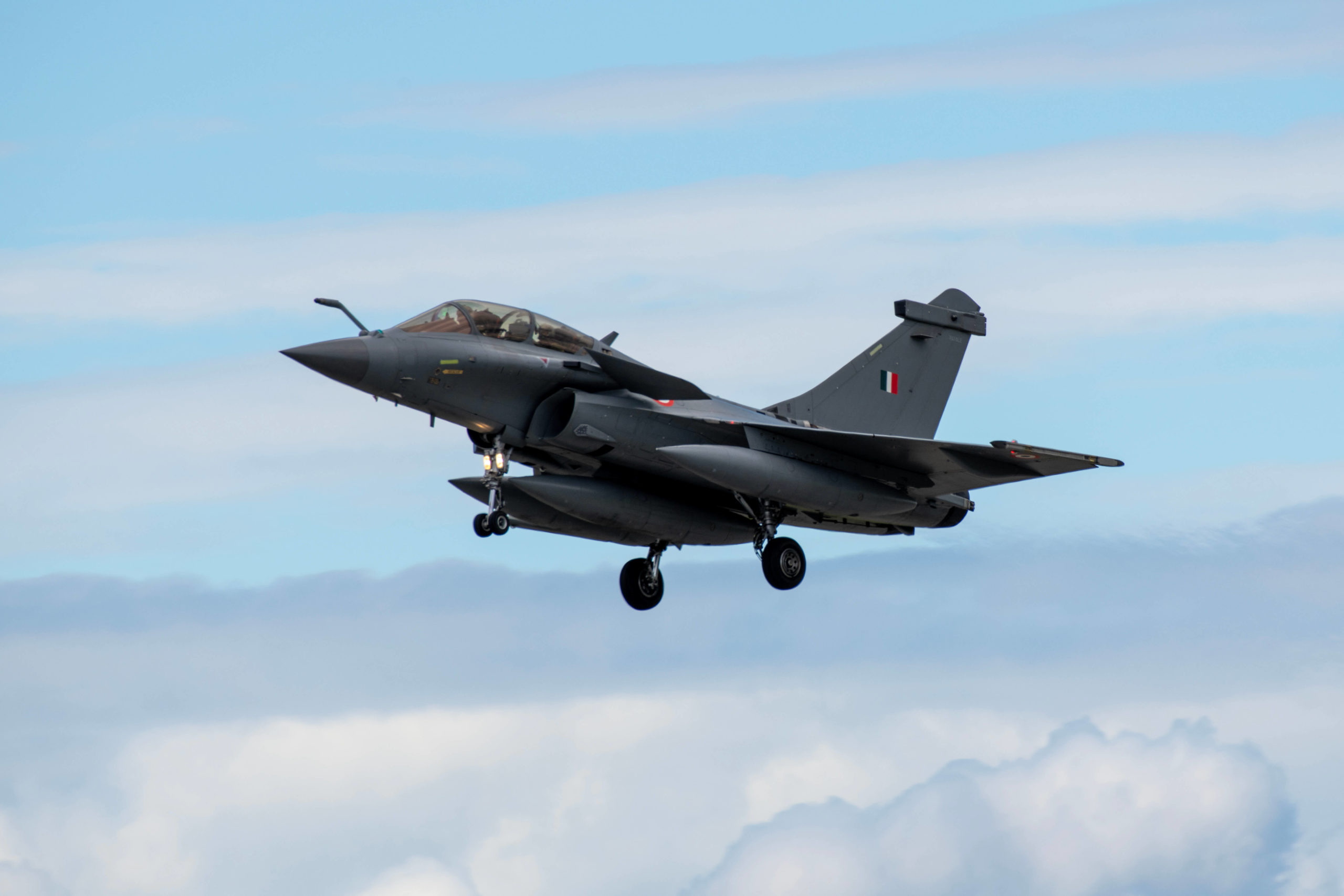By Air Marshal Anil Chopra (Retd)
New Delhi. Conscious of serious capability gaps, India’s Ministry of Defence (MoD) had announced formation of a high-level committee to address shortages in the Indian Air Force (IAF). For some time, the IAF has been grappling with the reduced fighter aircraft with the squadron strength coming to an all-time low of 31 vis-à-vis the authorised strength of 42.
The committee headed by Defence Secretary and senior officials is looking at the shortage of fighter jets, weapons, and other equipment and suggest solutions, including accelerating indigenous production, and selectively inviting foreign collaborations, amid growing security challenges from China, Pakistan, and now, perhaps Bangladesh. The report is expected by mid-March 2025.
Meanwhile China unveiled two sixth-generation fighter jets recently representing the next evolutionary leap. Pakistan plans to acquire 40 J-35 fighters from China, marking the first export of Beijing’s fifth-generation jets to a foreign ally. It could mean induction by around 2029. That will change the entire air dominance dynamics in the sub-continent. China’s potential sale of fighter jets to Bangladesh also adds to regional security concerns.
With delays in LCA program, IAF desperately needs the 114 Multi-Role Fighter Aircraft (MRFA).
MRFA Request for Information
The Indian government issued an RFI (Request for Information for 114 MRFA in 2018. As many as eight aircraft responded to the RFI. These include the Boeing F/A-18E/F Super Hornet, Boeing F-15EX Eagle II, Lockheed Martin F-21 (a variant of F-16V with 14 India-specific customizations), Dassault Rafale, Eurofighter Typhoon, Saab JAS-39 Gripen E/F, Mikoyan MiG-35, and Sukhoi Su-35.
Most aircraft had already participated in the MMRCA competition, which was clinched by Rafale after beating the Eurofighter Typhoon on price. Rafale’s naval version has been selected for the Indian Navy’s two aircraft carriers as a replacement for its aging MiG-29s.
MoD Reveals Intent
The MoD has recently revealed its intent to conduct an open tender for the MRFA project, aiming to procure 114 jets. It is poised to be one of the largest defence procurement projects in recent years. The Acceptance of Necessity (AoN) and the Request for Proposal (RFP) is likely to be issued in early 2025. The “open tender” for this to be Made-in-India aircraft brings in fresh dimensions that could tail-spin the whole process for extended selection process.
Earlier IAF acquired 36 Rafale through government-to-government (G2G) deal in 2016. Is the government playing it safe after the political slugfest and controversy that followed the Euro 7.87-billion Rafale deal? The Indian Government is clearly looking for a transparent, efficient procurement model in the MRFA tender.
Need for Fresh Trials?
Six of the eight contenders had gone through the MMRCA trails. But these trails happened in 2008-10. That is over 15 years ago. All aircraft have seen significant upgrades. But upgrades are primarily in avionics and weapons. There is thus a possibility to do limited trails.
Make-In-India Requirement
Indian government is considering stipulating in the RFP requirement of “full production” of the aircraft in India in a joint venture with a local partner. In case of Rafale and F-21, and some others, a certain number of components are already being produced in India. However, full aircraft production would be a significant development. Accompanying it is the requirement for full TOT (Transfer of Technology). This may be resisted by some. Nonetheless, in the competition are:
Saab JAS 39E/F Gripen
The Swedish Saab JAS 39 E/F Gripen is a light single-engine multirole fighter aircraft. The first-flight took place in 1988, and the initial variant inducted in the Swedish Air Force in 1996. The latest variant JAS 39E/F Gripen was inducted in the Swedish and Brazilian Air Forces in 2019. JAS 39 E/F have larger fuselage, a more powerful engine, increased weapons payload capability, and new cockpit, avionics architecture, electronic warfare system and other improvements. As of 2023, more than 300 Gripen variants have been built.
There is a proposed carrier-based version based on the Gripen E. There is also a proposed unmanned combat aerial vehicle (UCAV) variant of the Gripen E. Gripen EA is the proposed electronic warfare (EW) or Electronic Attack variant of the Gripen F.
The aircraft has been sourced roughly 67 percent from Swedish or European suppliers and 33 percent from the U.S. The engine, fuel, and hydraulics, are sourced from outside Sweden, albeit from global OEMs. On the other hand, the radar, avionics, software, mission computers, data and sensor fusion, and a lot more are indigenous. There is significant Artificial Intelligence (AI) embedded for quicker and better operational decision making, and enhanced network-enabled capabilities.
Sweden has offered to integrate Indian systems and weapons on the platform.
Some operators have adopted the less expensive GE F414G power-plant vis-à-vis the Eurojet EJ200. The version on offer to India can be with more powerful and more expensive EJ-200 engine. One plus point is that all operators have access to the Gripen’s source code and technical documentation, allowing for upgrades and new equipment to be independently integrated.
Saab has pledged full Gripen E technology transfer to India if it is awarded the contract. But some in India have been concerned about the high US-supplied hardware, and possibilities of disruption are not ruled out.
The current operating countries are Brazil. Czech Republic, Hungary, Thailand and South Africa. Sweden is the only country with significant numbers, over 100.
SAAB has tied with the Adani group as their production partner in India. The proposal has the backing of the Swedish government. When India begins manufacturing the GE F414 in India, then that could be an advantage.
SAAB promises delivery of the first Gripen to India in 36 months.
Boeing F/A-18IN
The Boeing F/A18E/F Super Hornet is a twin-engine multirole fighter. The aircraft evolved from YF-17 which had lost the USAF competition to F-16 in mid 1970s. The F-18 first flew in 1978 as Hornet, and is operated by US Marines and US Navy, among others. Nearly 1,500 Hornets have been built. The Hornet and Super Hornet have successfully taken part in the Gulf and Middle East wars. The Super Hornet has a new larger airframe and has seen extensive avionics upgrades. The aircraft is powered by two General Electric F414-400 turbofans. The variant likely to be offered will be customized for India and called F/A-18IN, and have a newer AESA radar.
Boeing and Tata joint-venture, the Tata Boeing Aerospace Limited (TBAL) facility at Hyderabad, supports India as a global exporter of aerospace. The 14,000 square meters facility makes aero-structures of Boeing’s AH-64 Apache helicopter for customers worldwide.
This is the first time the Super Hornet is being offered for production in a foreign country. The Indian Navy though has chosen to acquire 26 jets Rafale-M in preference to F-18s. That is a disadvantage.
Boeing F-15EX Eagle II
The Boeing F-15EX Eagle II is an advanced two-seat variant of F-15E Strike Eagle and made its maiden flight in February 2021. Improvements included the AMBER (Advanced Missile and Bomb Ejector Rack) system to carry up to 16 air-to-air missiles, AESA radar, ISTR (Infrared Search and Track), advanced avionics, electronic warfare equipment, conformal tanks, and revised structure with a service life of 20,000 hours. The USAF went ahead with these to maintain fleet size as F-22 production ended.
The USAF has ordered around 80 new aircraft. The Israeli Air Force ordered 25 F-15IA fighters and plans to upgrade 25 F-15Is to the F-15IA standard. The aircraft has a max-take-off-weight of 36.7 tons, similar in class as Sukhoi Su-30 MKI at 38.8 tons.
With over 260 Su-30 MKI with IAF, India would have to take a call if it requires such a large aircraft in numbers more than USAF.
Eurofighter Typhoon
The Eurofighter Typhoon is a twin-engine, multirole fighter manufactured by a consortium of Airbus, BAE Systems, and Leonardo formed in 1986. The aircraft entered operational service in 2003 and around 600 have been built till date and flown be 10 Air Forces.
The fighter is powered by two Eurojet EJ200 engines.
Eurofighter has seen operations in Libya. It was one of the two aircraft short-listed after technical evaluation during MMRCA competition along with Rafale but lost out on the commercial bid.
The upgrades of the aircraft include MBDA Meteor, Storm Shadow and Brimstone integration. There are upgrades to the AESA radar and EW (Electronic Warfare) suite.
Lockheed Martin F-21
The F-16 Fighting Falcon is a single-engine air-superiority, multi-role fighter aircraft which first flew in 1974 and has since been operated by 26 countries. It has been repeatedly upgraded, including with changes to the airframe. The aircraft today has latest technologies and modularity makes it easily further upgradable.
The F-21 would be India specific Block 70 variant. The aircraft will feature Northrop Grumman’s advanced APG-83 AESA radar and enhanced battle space awareness avionics.
On offer are also many weapons including the latest versions of the AIM-120 AMRAAM.
The aircraft is powered by GE F110-132A engine. The structural life of the aircraft has been extended to see it flying till 2040. Operational capabilities are enhanced through an advanced data-link, targeting pod and weapons; precision GPS navigation and the Automatic Ground Collision Avoidance System (Auto GCAS).
At one stage, the offer was to shift the entire F-16 manufacture
ing line to India and make India the global supply chain hub. With 2250 F-16 still flying in 26 countries, it would mean a very significant move.
Lockheed Martin has a joint venture company with Tata Advanced Systems Limited (TASL) which has proven expertise through manufacture of airframe components for the C-130J airlifter and the S-92 helicopter. F-16 Wings are being produced in India for global customers. If selected, Lockheed Martin and Tata would produce the F-21 in India, for India, and the world.
Mikoyan MiG 35
The Mikoyan MiG-35 is a Russian multi-role fighter which is essentially a further development of the MiG-29M2. MiG-35 was first presented internationally during the Aero India 2007. The single-seat version is designated MiG-35 and the two-seat version MiG-35D.
The fighter has improved avionics and weapon systems, including a new AESA radar and precision-guided targeting capability. With IAF having already upgraded the MiG-29s, India has partially imbibed some of these technologies already.
Sukhoi Su-35
The Sukhoi Su-35 is yet another upgrade of the Su-27 air-defence fighter family. It is a single-seat, twin-engine, super manoeuvrable, multi-role aircraft. The two-seater version resembles the Su-30MK family.
The Su-35 has a redesigned cockpit and weapons-control system and features thrust-vectoring engines and has no canards. The type made its first flight in February 2008. It is currently operated by the Russian Air Force and China’s People’s Liberation Army Air Force (PLAAF).
With India having very large numbers of Su-30MKI, and also a proposal to upgrade them, Su-35 may not be that attractive.
Rafale
After a gruelling selection process, the omni-role Rafale had come out winner in the MMRCA tender. It has been operationally tested in Afghanistan, Libya, Mali, Iraq and Syria. The fleet is fully operational in IAF.
India has infrastructure for two airbases. Also India has paid for one time India specific enhancements. The F4 is the latest variant with radar and sensor upgrades that facilitate the detection of airborne stealth targets at long range, and improved communications equipment for more effective network-centric warfare. It’s variant is on offer. In view of IAF’s depleting numbers, albeit expensive, one school of thought favours to order additional Rafale. The Indian Navy has also opted for its naval variant, Rafale-M, and the deal is likely to be signed before Aero India 2025. These additional numbers would support Make-in-India.
Rafale’s Huge Backlog
Another reason New Delhi is looking for a fresh procurement process is Dassault’s perceived inability to supply the Rafale in a short-to-medium timeframe due to a huge backlog of orders from other countries.
Dassault has said it could increase production to at least three aircraft per month, which would significantly ease the bottleneck. Such decisions inevitably mean expanding workforces, factories and tooling, all requiring sizeable investment. Some suppliers may worry that a 30-plus production rate will not be sustainable and could burden them with costly excess capacity if demand later drops.
Multiple Fleets Complexities
While the trend world-wide is to have limited fleet types, IAF continues to be mired by multiplicity of fighter fleets with Jaguar, Mirage 2000, Su-30, MiG-21, Mig 29, LCA and Rafale. Adding more types would mean continued logistics nightmare.
Larger fleets can amortise costs and can maintain decent spare backups. Ideally IAF should settle for SU-30 MKI, Rafale and LCA fleets in the long run with one new fighter and AMCA later. But price and technology considerations matter eventually.
Nearly 65 percent of the IAF continues to be of Russian origin. This dependency on a single country has to reduce. This has become clearer after the Ukraine conflict. My personal assessment is that in next 20 years, India must target a percentage mix of 40 Indian, 30 Western and 30 Russian aircraft.
To Summarise
The delays in indigenous LCA development has resulted in IAF squadrons continuing to reduce.
Despite IAF committing to 40 LCA Mk 1, 83 plus 97 LCA Mk1A, and having given tacit approval for as many as 120 LCA Mk II (may go up to 200 later), the inductions have remained slow. The LCA Mk II and initially the fifth-generation indigenous Advanced Medium Combat Aircraft (AMCA) will be using GE F414 engine. The F 414 is to be manufactured in India.
China has been pulling ahead in both numbers and quality. They have built nearly 300 fifth-generation J-20 aircraft, and plan to increase the numbers to 1,500 by 2035.
LCA Mk1A is currently behind schedule. Deliveries may still be completed by 2029. The Mk2 is now planned to roll out around August 2025, and make the first flight in March 2026, and induction around 2032.
The AMCA may make its first flight around 2028. It can induct earliest only around 2035. AMCA would require some foreign technological support, some of which can be factored in the new fighter selection package.
Most major powers are reluctant to share their latest technologies, more so with one of the major arms importer.
The necessity of 114 additional fighters is very clearly spelt out. The starting point is issuing of the RFP. Once the RFP responses are received, the extent of evaluation would have to be decided to save time.
Commercial considerations and the level of technology transfer on offer would decide the ultimate winner.
Any deal for the new fighter would have to have in-built in the contract maximum technology transfer and support for India’s LCA, AMCA, AESA radar and aircraft engine programs.
The Saab Gripen JAS-39 is the more recent aircraft with fairly modern technologies. Being an overall smaller political player for India it will be easier to get a good deal from Saab. They are willing to share the source-code. However, only 300 Gripen are flying world over giving little business leverage for any exports. Also the original Saab plant will not be shut down. Nearly 30 percent aircraft systems are sourced from USA, which can have complications later.
F-18 is a twin-engine aircraft, and its airframe has recently been redesigned. Boeing has significant presence in the country. But if Indian Navy goes ahead with Rafale-M then the numbers for F-18 “Make in India” would reduce.
F-16 (F-21) has the largest fleet in the world, many of which will be flying well past 2040. India can get huge business worldwide for maintenance and overhauls.
With the MiG-29 upgrade, some of the technologies have already been imbibed. So MiG-35 is unlikely to be a contender.
Earlier the Eurofighter had lost out to Rafale on the commercial bid. New commercial bids would have to be seen. Rafale has the advantage is naval variant already selected by the Indian Navy, thus it has the advantage of numbers.
Despite much refined DPP-2020, amended in 2022, the only contracts that seem to have gone through have all been G2G deals.
All deals with Soviet Union and Russian in the past were G2G. Also with Americans (P-8I, C-17, C-130, Apache, Chinook and others) and French (Rafale) were G2G.
G2G deals save time, help avoid unnecesssaey allegations like those raised by some politicians in the 1980s Bofors howitzer deal with Sweden, and price stability is inbuilt. A G2G approach would still be the best for the selected fighter, for both cost and time savings.
An early decision is operationally most critical.
Featured image: An Indian Air Force Rafale lands during Red Flag-Alaska 24-2 at Eielson Air Force Base, Alaska, June 6, 2024. RF-A exercises are focused on improving the combat readiness of U.S. and international forces and providing training for units preparing for air and space expeditionary force taskings. (U.S. Air Force photo by Airman 1st Class Samantha White) (This photo has been altered due to partner country privacy concerns by blurring out the aircraft tail)
This article was published by our partner India Strategic on 30 January 2025.





